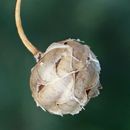Comments
provided by eFloras
Cyperus esculentus is a widespread and polymorphic species. Although seven varieties have been recognized (G. Kükenthal (1935–1936), recent studies based primarily on spikelet features provided support for four varieties (P. Schippers et al. 1995). Cyperus esculentus var. esculentus is restricted to the Old World.
- license
- cc-by-nc-sa-3.0
- copyright
- Missouri Botanical Garden, 4344 Shaw Boulevard, St. Louis, MO, 63110 USA
Comments
provided by eFloras
Often mixed with pale coloured races of the polymorphic C.rotundus, but stolons more slender and tubers more regularly zoned, glumes less closely imbricating and glume side with several distinct, pale nerves.
- license
- cc-by-nc-sa-3.0
- copyright
- Missouri Botanical Garden, 4344 Shaw Boulevard, St. Louis, MO, 63110 USA
Description
provided by eFloras
Herbs, perennial, stoloniferous; stolons soft, spongy, flexible when dried, 2–8(–15) cm, bearing tubers (3–)6–11 mm diam. Culms trigonous, 15–60 (–100) cm × 0.6–3.4 mm, glabrous. Leaves 3–7, flat to V-shaped or flanged V-shaped, (6–)20–40(–80) cm × 2–4 (–6.5) mm. Inflorescences: spikes broadly ellipsoid to ovoid or hemispheric, (12–)18–30 × (12–)18–35 mm; rachis 4–17 mm; rays 4–10, (0.3–)2–12 cm; bracts (3–)4–5(–7), ± horizontal to ascending at 45(–75)°, V-shaped to flanged V-shaped, (1.5–)5–30 cm × 0.5–4 mm; rachilla persistent, wings hyaline, 0.3–0.5 mm wide. Spikelets (3–)10–20(–28), divaricate or ascending, yellowish brown to dark brown, linear to linear-lanceoloid, compressed-quadrangular, (5–)10–20(–55) × (1.2–)1.4–2(–3) mm; floral scales persistent, 6–34, spreading or appressed, ovate-lanceolate, laterally 7–9-ribbed, laterally yellowish brown to dark brown medially brownish, reddish, or greenish, ovate, or ovate-deltate, medially 3-ribbed, 1.8–2.7(–3.4) × (1–)1.5–1.8(–2.4) mm, apex acute or sub-acute. Flowers: anthers (1–)1.2–1.5(–2.1) mm; styles (0.7–)1–1.2(–2.2) mm; stigmas (1.2–)1.8–2.3(–4) mm. Achenes (seldom maturing) brown, sessile, ellipsoid, (1.1–)1.3–1.5(–1.6) × 0.3–0.6(–0.8) mm, apex obtuse, surfaces puncticulate.
- license
- cc-by-nc-sa-3.0
- copyright
- Missouri Botanical Garden, 4344 Shaw Boulevard, St. Louis, MO, 63110 USA
Description
provided by eFloras
Perennial, 30-80 cm. Base of stem slightly swollen, with stolons to c. 20 cm, tuber up to 15 mm diam., round or elongate, rooting, covered by greyish-brown scales. Stem 2-3 mm diam., trigonous, smooth. Leaves shorter than stem; sheaths 50(-100) mm, yellowish or greyish brown, sometimes with reddish tint, mouth margin nearly straight or lingulate; blades to 30(-60) cm, to 5 mm wide, yellow-green, keeled, margin slightly revolute, smooth or towards apex scabrous, apex acute, trigonous, scabrous. Inflorescence an anthelodium, primary rays to more than 10, to 80 mm; lowest 2-3 bracts leaf-like, up to 30 cm, 5 mm wide, sheathless; primary branches end with often more than 20 spreading spikes in irregular spiral, but small secondary anthelodia frequent. Spikes up to 15 x c. 1.5 mm, elongating after flowering, with 5-12 flowers; glume-like bract c. 2 mm, glume-like prophyll two-veined, c. 1.5 mm, base swollen; rachis compressed, slightly zigzagging, internodes c. 1 mm, winged; glumes 2-2.5 mm, cymbiform, blunt, yellow-brown, with 5-9 conspicuous veins, mid-vein strong, with short mucro below glume apex, margins scarious. Nut c. 1.5 mm, ovoid or obovoid, obtusely trigonous, yellow-brown or dark-brown, surface reticulate-papillose.
- license
- cc-by-nc-sa-3.0
- copyright
- Missouri Botanical Garden, 4344 Shaw Boulevard, St. Louis, MO, 63110 USA
Distribution
provided by eFloras
S. Europe, Africa, India, Nepal, America.
- license
- cc-by-nc-sa-3.0
- copyright
- Missouri Botanical Garden, 4344 Shaw Boulevard, St. Louis, MO, 63110 USA
Distribution
provided by eFloras
Distribution: Concentrated in tropical and subtropical Africa, but a weed in all continents; formerly cultivated, especially in the Mediterranean, for edible tubers rich in carbohydrates and oil (earth almond, chufa).
- license
- cc-by-nc-sa-3.0
- copyright
- Missouri Botanical Garden, 4344 Shaw Boulevard, St. Louis, MO, 63110 USA
Elevation Range
provided by eFloras
100-2300 m
- license
- cc-by-nc-sa-3.0
- copyright
- Missouri Botanical Garden, 4344 Shaw Boulevard, St. Louis, MO, 63110 USA
Flower/Fruit
provided by eFloras
Fl. Per.: April-July.
- license
- cc-by-nc-sa-3.0
- copyright
- Missouri Botanical Garden, 4344 Shaw Boulevard, St. Louis, MO, 63110 USA
Habitat
provided by eFloras
Sandy river-sides, humid forests; irrigated fields.
- license
- cc-by-nc-sa-3.0
- copyright
- Missouri Botanical Garden, 4344 Shaw Boulevard, St. Louis, MO, 63110 USA
Synonym
provided by eFloras
C. aureus Tenore, Fl. napol. Prodr. "I.(1811) VIII." Holm & al., World's Worst Weeds: fig. 46. 1977. Haines & Lye, Sedges and Rushes E. Afr.: figs. 372 & 373. 1983.
- license
- cc-by-nc-sa-3.0
- copyright
- Missouri Botanical Garden, 4344 Shaw Boulevard, St. Louis, MO, 63110 USA

